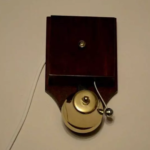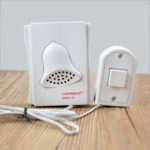A bell is installed in almost any house, which signals the owners about the arrival of guests. Despite the simplicity of the design, the equipment is modernized every year and supplemented with various functions. You can see who has come, even at a great distance, choose a specific melody and use a number of other useful things. The more complex the device used, the more difficult it is to connect an electric bell in an apartment.
What are doorbells
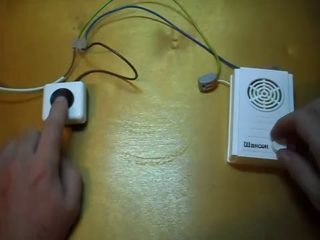
There are many models, each of which has its own connection method, operating principle, and available functions. All these parameters will ultimately necessarily affect the cost of the purchased device.
There are three main options for the connection method:
- Mechanical. In the majority of cases, they perform a decorative function. They are located in the hallway or on the facade. They make themselves felt when a person tries to open the door or touches the tongue of the bell.
- Electromechanical. A more advanced model of the previous type, which differs in a rather simple, but more convenient design, which provides for the presence of a button for signaling, which is located outside the house or apartment. There is also a resonator, which is mounted in a living room, and an electrical cable that connects both parts of the device.
- Electronic. The most advanced version, which is assembled on the basis of microcircuits and is equipped with a built-in speaker. The variety of sounds that such equipment can make is unlimited. The use of electronics also expands the available list of functions of such devices.
You can find wired and wireless electronic calls on sale. The first type is connected in much the same way as most electromechanical devices. However, you can find models that are additionally provided with protection in the form of a power supply from a voltage of 12 volts or using batteries. They must be connected via a dedicated step-down transformer or power supply. On the button in such devices, a low-voltage signal is broken instead of a phase.
Wireless calls are easy to use, but the transmitter button often requires constant updating of the autonomous power supply, and at the same time must be in an area that will not interfere with signal transmission to the device. Some wireless models work when connected to a standard 220V network, to an ordinary outlet, while in the button you will need to periodically change the batteries. Other models have both self-powered cells.
Modern wired and wireless calls have become a full-fledged security system, providing for the use of devices for sound recording and video surveillance. In this regard, the wired call connection scheme will change depending on what additional devices will be used in conjunction with it.
There are a number of models that can open gates remotely or swing open front doors. This is a fairly convenient feature for a private home.
If you need to connect a wireless call to an apartment with video surveillance, the procedure will be much more complicated.It is better to entrust the work to specialists who will be engaged in the maintenance of the equipment in the future.
How to set up and connect a call
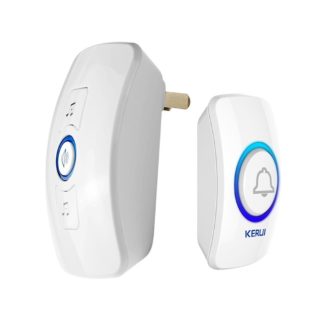
To connect a wired bell or a wireless device, you need to study the features of the selected design, as well as the type of room.
Wireless
Wireless devices are the easiest to connect, especially if you plan to install a device that will be plugged directly into an electrical outlet. In this case, you will need to fix the button on the wall or door frame near the front door. Depending on what material the base is made of, you will need to use self-tapping screws or appropriate dowels for fastening.
It is enough to decide where in the house the most convenient place for the button is. After that, the device itself is applied to the wall surface, marks are placed through the holes for fasteners. Holes are drilled with a perforator, into which you will need to drive the fasteners and screw the button with all the batteries. If the button is mounted on a wooden surface, the procedure is easier, since only self-tapping screws need to be used.
The main unit is plugged into an outlet. Usually one of the sockets in the hallway is chosen at a minimum distance from the button.
A wireless call is an optimal solution for a private house, since the installation of such equipment does not imply the need to lay electrical wiring through the entire territory of the yard. In this case, you need to take into account some restrictions:
- The choice of the device must be carried out taking into account that the button will be on the street. If the degree of protection is insufficient, the button itself or its batteries may break due to high humidity or strong temperature changes.
- There should not be any metal or concrete obstacles between the button and the bell, as they can block the signal flow, the bell will not work.
- In the process of choosing a wireless call, it is important to carefully read all the technical characteristics of the model, see the range of reliable signal reception, which in most cases is within 80-100 meters, which is quite enough for normal operation in a private house.
Installing a wireless doorbell is straightforward, but in some cases such devices are less reliable. They also require periodic replacement of the power supply.
Wired
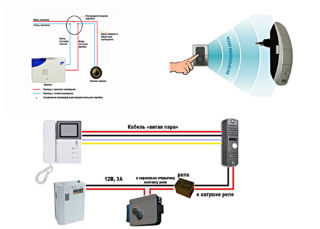
The difference between an apartment and a private house when installing a wired bell is solely in the length of the cable. If you plan to install such a device in an apartment, you need to fix the button near the door, as in the case of the wireless option. However, it must be connected to a cable brought into the housing through a hole made in the wall or door frame. You need to make sure that the wires are protected and there is no open access to them.
If the wire is passed to a wooden box, a groove is carefully made on the section of the wall that goes between them, which is then sealed. The main unit, if desired, can be fixed in any convenient place in the room. As a rule, this is the wall of the hallway. Inside the apartment, all wires can also be hidden in the grooves made, but sometimes the option with a cable channel in the form of a kind of plastic box is used, designed for safe arrangement of electrical wiring.
It is more difficult to install equipment in a private house if you need to install a button on the gate. You will have to pull a very long wire, equipped with insulation in the form of a special corrugated tube, which provides protection from moisture, temperature extremes and sunlight. When buying a cable from a store, you should ask the seller if it is designed for use in an open area. Some manufacturers make products exclusively for indoor installation.
Connection procedure:
- The house is completely de-energized through the circuit breakers on the switchboard.
- The main unit case is opened.
- The ends of the connecting cable are carefully cleaned, after which one of them is laid in the strobe to the bell, and the second to the place where the button is planned to be installed.
- The zero wire is connected to the one that will go to the bell through the terminal.
- The phase wire is similarly combined with the wire that goes to the button. The second conductor of this cable will need to be switched with the second wire going directly to the bell itself.
- Both cables that go to the button are carefully stripped and then clamped in its terminals. The button itself is assembled, since you no longer need to work with it.
- The cables leading to the bell from the junction box must be clamped in the terminals and combined with those that come from the bell body.
Some craftsmen prefer to use twists instead of terminals, but this option is optimal only if there are contact caps. The version with terminals is more affordable and reliable, since calls do not differ in heavy loads.


